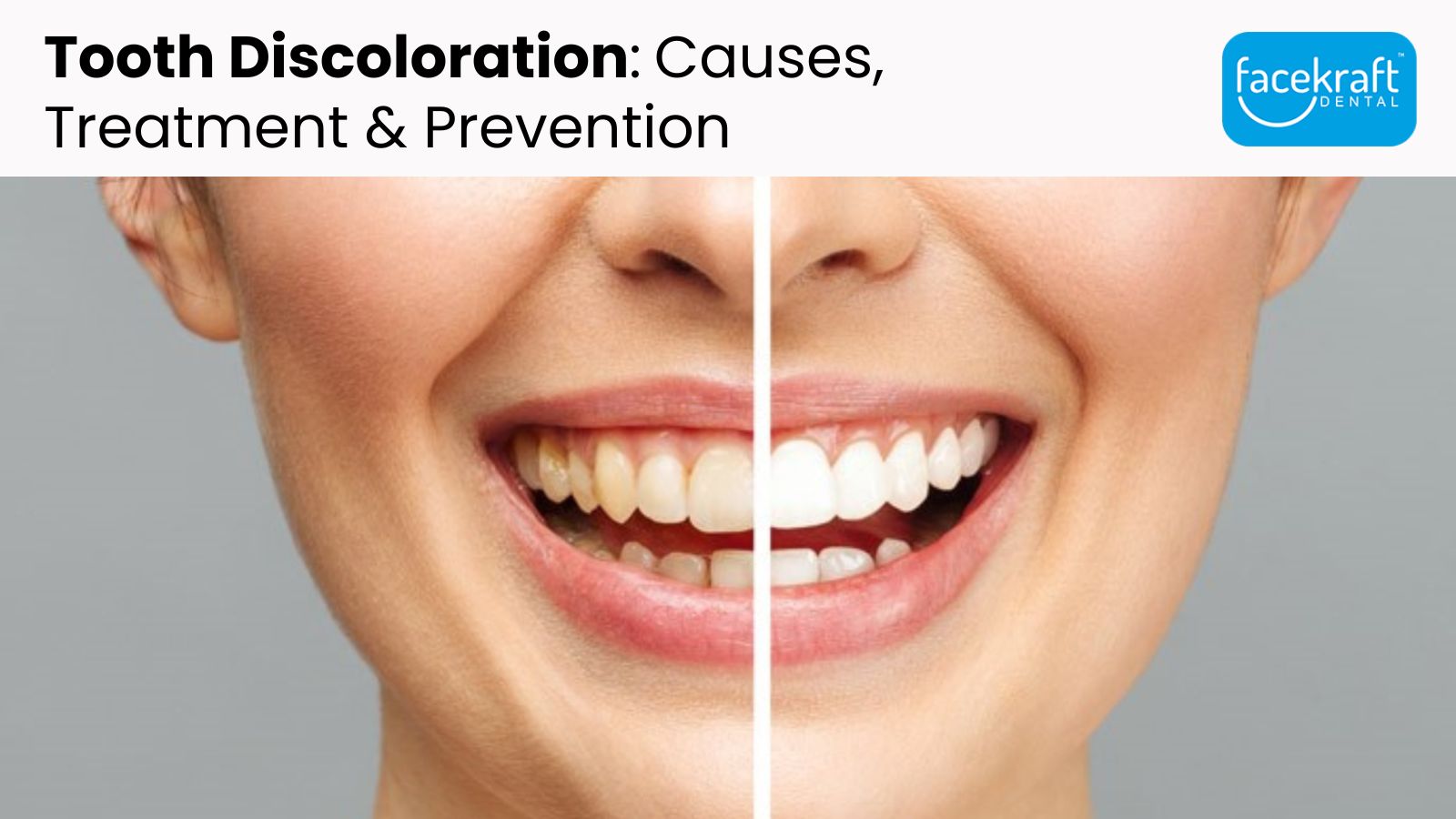Tooth Discoloration: Causes, Treatment & Prevention

Tooth Discoloration: Causes, Treatment & Prevention
Tooth discoloration refers to any change in the natural color of teeth, causing them to appear yellow, brown, grey, or even blue or green in some cases. There are several potential causes of tooth discoloration, and treatment and prevention strategies can vary depending on the underlying issue. Here’s an overview of tooth discoloration, its causes, treatment options, and preventive measures:
Causes of Tooth Discoloration:
Extrinsic Stains: These stains occur on the outer surface of the tooth enamel and are often caused by consuming foods and beverages that stain, such as coffee, tea, red wine, and certain fruits. Smoking or using tobacco products can also lead to extrinsic stains.
Intrinsic Stains: Intrinsic stains result from changes within the tooth structure itself. Common causes include:
Dental Trauma: A blow to the tooth can cause it to become discolored due to damage to the pulp (the innermost part of the tooth).
Aging: Over time, the enamel naturally thins, allowing the yellowish dentin beneath it to show through.
Medications: Some medications, such as tetracycline antibiotics, can cause intrinsic tooth discoloration, especially when taken during tooth development in childhood.
Fluorosis: Excessive fluoride intake during tooth development can lead to enamel discoloration.
Genetics: Some individuals may have naturally darker or more translucent enamel, making their teeth appear discolored.
Systemic Factors: Certain medical conditions and diseases, such as liver disease or jaundice, can lead to tooth discoloration.
Treatment Options:
Professional Teeth Whitening: The best Dentist in Jaipur or best dental clinic can perform in-office teeth whitening procedures using peroxide-based solutions. Over-the-counter whitening products, such as whitening strips and gels, are also available but may be less effective.
Dental Bonding: In cases of mild teeth discoloration, dental bonding can be an option. A tooth-colored resin is applied to the tooth’s surface and then shaped and polished to match the surrounding teeth.
Porcelain Veneers: For more severe discoloration or other cosmetic issues, porcelain veneers can be an effective solution. These thin shells are custom-made and bonded to the front of teeth to improve their appearance.
Dental Crowns: When tooth discoloration is due to dental trauma or other structural issues, a dental crown may be recommended. Crowns are caps that cover the entire tooth, providing strength and a natural appearance.
Root Canal Therapy: If intrinsic discoloration is caused by damage to the tooth’s pulp, a root canal procedure may be necessary to remove the damaged tissue and restore the tooth’s color.
Prevention Strategies:
Maintain Good Oral Hygiene: Brushing, flossing, and regular dental check-ups can help prevent extrinsic stains and keep your teeth healthy.
Limit Stain-Causing Foods and Drinks: Reduce your consumption of coffee, tea, red wine, and tobacco products to minimize extrinsic staining.
Use a Straw: When drinking staining beverages, using a straw can help reduce contact with your teeth.
Fluoride Control: Be cautious with fluoride intake, especially for children, to prevent fluorosis. Use fluoride toothpaste in moderation.
Protect Teeth: Wear a mouthguard during sports to prevent dental trauma, and avoid biting hard objects that could damage your teeth.
Professional Cleanings: Regular dental cleanings can remove surface stains and plaque buildup.
EndNote
Tooth discoloration is a common issue, and its treatment and prevention depend on the underlying cause. Consult with your dentist to determine the best approach for addressing your specific discoloration concerns.
